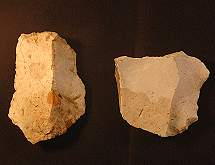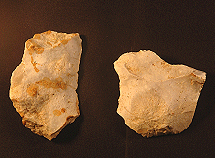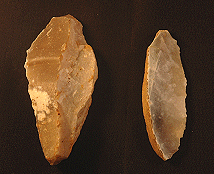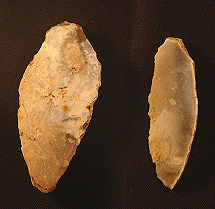|
Artefact or Geofact?
Flint nodules are often broken apart by
natural processes. Sometimes the resulting flakes can look
misleadingly like a human artefact or struck flint. Such natural
flakes are known as geofacts.
The processes that can produce geofacts include frost shattering,
where water gets into crevices in the flint and expands when frozen, the
knocking of flints together due to earth or soil movements, and damage
caused by ploughing and harrowing the soil.
Some geofacts, such as those illustrated right, are so similar in
appearance to flint tools that only careful closeup examination will
show their true nature and hence are very misleading to archaeologists
and collectors. They even seem to have some of the detailed
characteristics of a struck flint.
That they are geofacts is revealed by the lack of the remains of a
true striking platform, and lack of a striking point or bulb of
percussion. They often have rough rather than smooth facets and
lack ripples caused by a deliberate blow. Identification is often made
difficult because geofacts may have uniform patination, 'iron
mould' stains, and they can resemble common tool type shapes; scrapers,
axes, points and arrow heads.
|

These flints seem to be artefacts on one side but . . . .

Turn them over and they have no platform and no bulb of
percussion.

These two are equally convincing

Until you turn them over
|